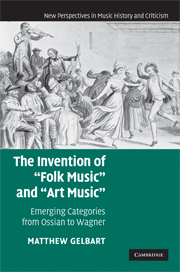Book contents
- Frontmatter
- Contents
- List of music examples
- Acknowledgements
- Introduction
- 1 Function to origin: national identity and national genius emerge, c. 1700–1780
- 2 From pastoral to picturesque: nature, art, and genre in the later eighteenth century
- 3 Genius versus art in the creative process: “national” and “cultivated” music as categories, 1760–1800
- 4 The invention of folk modality, 1775–1840
- 5 “Folk” and “tradition”: authenticity as musical idiom from the late eighteenth century onward
- 6 Organic “art music” and individual original genius: aestheticizing the folk collective
- 7 Local nation and universal folk: the legacy of geography in musical categories
- 8 Folk and art musics in the modern Western world
- Index
Introduction
Published online by Cambridge University Press: 22 September 2009
- Frontmatter
- Contents
- List of music examples
- Acknowledgements
- Introduction
- 1 Function to origin: national identity and national genius emerge, c. 1700–1780
- 2 From pastoral to picturesque: nature, art, and genre in the later eighteenth century
- 3 Genius versus art in the creative process: “national” and “cultivated” music as categories, 1760–1800
- 4 The invention of folk modality, 1775–1840
- 5 “Folk” and “tradition”: authenticity as musical idiom from the late eighteenth century onward
- 6 Organic “art music” and individual original genius: aestheticizing the folk collective
- 7 Local nation and universal folk: the legacy of geography in musical categories
- 8 Folk and art musics in the modern Western world
- Index
Summary
Americans of recent generations will remember a game on the children's television show Sesame Street called “One of these things is not like the others,” which teaches young children to balance similarities and differences by establishing categories. Most people today would have no problem playing that game with these three tunes:
the Scottish fiddle dance tune “John Anderson My Jo,” probably derived from a bawdy song;
“MacLeod's Rowing,” a Piobaireachd (“pibroch”) for Highland bagpipe;
Jean-Baptiste Lully's air “Sommes-nous pas trop heureux” from the ballet L'Impatience (1661).
The last here certainly seems the odd one out. It is French and the other two are Scottish. More importantly, by today's usual reckoning standards, it is “classical”: part of a well-funded world of urban, sophisticated music-making – and part of a literate tradition in which authorship is clearly established, and pieces are communicated as fixed texts reflecting that author's apparent intentions. The other two tunes, meanwhile, are apparently varieties of “folk” or “traditional” music: part of a communal tradition, usually disseminated anonymously through oral communication, and thus undergoing constant minor variations and additions.
Facile categorizations such as those encouraged by the Sesame Street game are always problematic on closer view of course, and “folk” and “classical” are among the most problematic of all. For example, one could easily argue, as many writers now do, that the pibroch is a form of classical music.
- Type
- Chapter
- Information
- The Invention of 'Folk Music' and 'Art Music'Emerging Categories from Ossian to Wagner, pp. 1 - 13Publisher: Cambridge University PressPrint publication year: 2007

